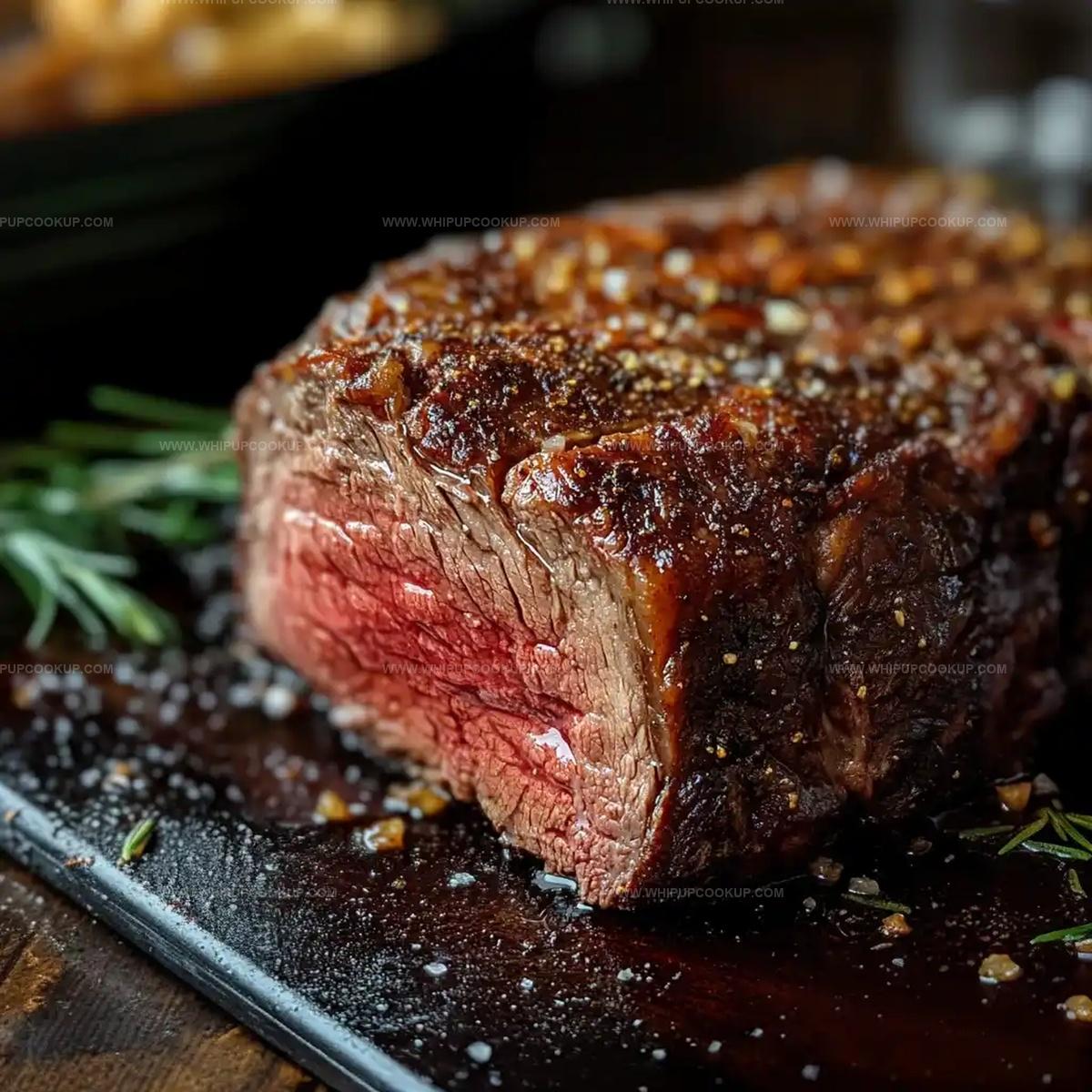The Ultimate Standing Rib Roast Recipe for Juicy Perfection
Crafting an exquisite standing rib roast requires precision and culinary passion that will transform your dinner table.
Robust beef cuts demand careful handling and strategic cooking techniques.
Meat lovers appreciate the rich marbling and tender texture of this classic centerpiece.
Professional chefs recommend selecting high-quality prime grade beef for maximum flavor intensity.
Salt and pepper create a simple yet elegant seasoning approach that enhances natural meat characteristics.
Temperature control becomes crucial when aiming for that perfect medium-rare result.
You can achieve restaurant-quality results with patient preparation and confident technique.
Each slice promises a mouthwatering experience that will impress even the most discerning palates.
Why Standing Rib Roast Impresses
Rib Roast Ingredient Essentials
Main Protein:Seasoning Ingredients:Cooking Ingredients:How to Roast Rib Perfectly
Step 1: Prepare The Meat
Pat the standing rib roast completely dry with paper towels.
This ensures perfect browning and helps create a delicious crust during cooking.
Ingredients to have ready:Generously sprinkle kosher salt all over the roast.
Cover loosely and refrigerate for 12-48 hours to enhance meat’s natural flavors.
Step 2: Season With Herb Blend
Remove roast from refrigerator one hour before cooking to reach room temperature.
Create a robust seasoning mixture by combining:Spread a thin layer of Dijon mustard across the meat’s surface.
Press herb mixture firmly into the mustard coating.
Step 3: Sear The Roast
Heat a large oven-safe skillet over medium-high heat.
Add olive oil and carefully place roast into hot pan.
Sear each side for 3-4 minutes until deep golden brown.
Step 4: Start Roasting
Preheat oven to 450°F.
Transfer seared roast to roasting pan with bone-side down.
Insert meat thermometer into thickest section without touching bone.
Step 5: Control Cooking Temperature
Roast at 450°F for 15-20 minutes to develop crispy exterior.
Reduce oven temperature to 325°F.
Continue cooking until internal temperature reaches desired doneness.
Step 6: Rest And Relax
Remove roast from oven when temperature hits 125°F for medium-rare.
Tent loosely with aluminum foil.
Allow meat to rest 15-20 minutes.
Step 7: Carve And Serve
Using a sharp knife, slice between bones into thick, juicy portions.
Serve immediately with preferred side dishes.
Tips for Juicy Rib Roast
Rib Roast Storage and Reheating
What Complements Rib Roast
Rib Roast Flavor Variations
FAQs
Prime rib or choice-grade beef with good marbling is ideal. Look for a roast with a thick fat cap and nice white fat streaks throughout, which ensure tenderness and rich flavor.
Yes, you can skip dry brining, but it significantly enhances meat flavor and texture. If you’re short on time, season the roast right before cooking and it will still be delicious.
Use a meat thermometer inserted into the thickest part, away from bone. For medium-rare, aim for 125°F (52°C). Remember the temperature will rise 5-10 degrees during resting, so remove it slightly before your target temperature.
Resting allows meat juices to redistribute, ensuring each slice is juicy and tender. If you cut immediately after cooking, all the flavorful juices will run out, leaving the meat dry and less flavorful.
Print
How to Cook a Perfect Standing Rib Roast Recipe
- Total Time: 14 hours
- Yield: 6 1x
Description
Succulent standing rib roast brings classic holiday elegance to dinner tables with its rich, tender meat and gorgeous golden crust. Rich beef flavors and perfectly roasted edges invite diners to savor each memorable slice of this centerpiece protein.
Ingredients
Main Ingredients:
- 3–4 ribs (about 5–7 lbs) standing rib roast (bone-in)
- 2 tablespoons kosher salt
- 2 tablespoons freshly ground black pepper
Herbs and Seasonings:
- 6 cloves fresh garlic (minced)
- 2 tablespoons fresh rosemary (chopped)
- 2 tablespoons fresh thyme (chopped)
- 2 tablespoons olive oil
- 2 tablespoons dijon mustard (optional)
Optional Additions:
- 2 tablespoons butter (optional)
- 1 cup beef stock (optional)
Instructions
- Salt the roast thoroughly with kosher salt, creating a dry brine. Wrap loosely and refrigerate for 12-48 hours to enhance meat’s flavor and tenderness.
- Remove roast from refrigerator and pat dry. Coat generously with freshly ground black pepper, minced garlic, chopped rosemary, and thyme. Optional: spread thin layer of Dijon mustard to help seasonings adhere.
- Preheat oven to 450°F, preparing for initial high-heat searing to develop a rich, caramelized exterior.
- Heat olive oil in large oven-safe skillet over medium-high heat. Sear roast on all sides until deep golden brown, approximately 3-4 minutes per surface.
- Position roast bone-side down on roasting rack. Insert meat thermometer into thickest portion, avoiding bone contact.
- Roast at 450°F for 15-20 minutes to create crusty exterior. Reduce temperature to 325°F and continue cooking approximately 1.5 hours until internal temperature reaches 125°F for medium-rare.
- Remove from oven and tent loosely with aluminum foil. Allow meat to rest 15-20 minutes, enabling juice redistribution and ensuring maximum tenderness.
- Slice between bones using sharp knife, creating thick, succulent portions. Serve immediately with complementary side dishes.
Notes
- Pat the meat completely dry before seasoning to ensure a perfect golden-brown crust that seals in delicious flavors.
- Select a high-quality, well-marbled standing rib roast for maximum tenderness and rich, juicy results.
- Use a reliable meat thermometer to avoid overcooking and guarantee precise doneness every single time.
- Consider allowing the roast to come to room temperature for about an hour before cooking to promote even heat distribution and consistent cooking throughout the meat.
- Prep Time: 12 hours (optional dry brine)
- Cook Time: 2 hours
- Category: Dinner
- Method: Roasting
- Cuisine: American
Nutrition
- Serving Size: 6
- Calories: 350
- Sugar: 0 g
- Sodium: 580 mg
- Fat: 24 g
- Saturated Fat: 9 g
- Unsaturated Fat: 12 g
- Trans Fat: 1 g
- Carbohydrates: 0 g
- Fiber: 0 g
- Protein: 30 g
- Cholesterol: 90 mg


Olivia Bennett
Recipe Developer & Culinary Educator
Expertise
Education
Schoolcraft College
With an Associate Degree in Culinary Arts from Schoolcraft College and a natural knack for teaching, Olivia Bennett’s all about making home cooking feel possible, even on your busiest day.
Her thing? Recipes that are budget-friendly, season-forward, and full of Southern warmth. Whether it’s a roasted veggie bowl or a five-ingredient skillet bake, Olivia makes sure it’s simple, satisfying, and something you’ll want to make again tomorrow.
When she’s not shooting step-by-step videos or testing spice blends, she’s out foraging, flipping through old cookbooks, or throwing laid-back dinner parties with a BYO-mason-jar theme.